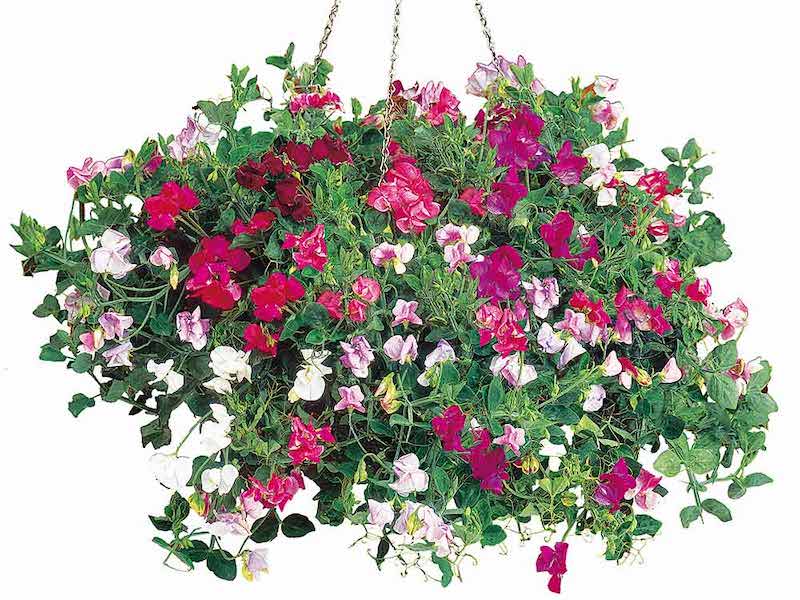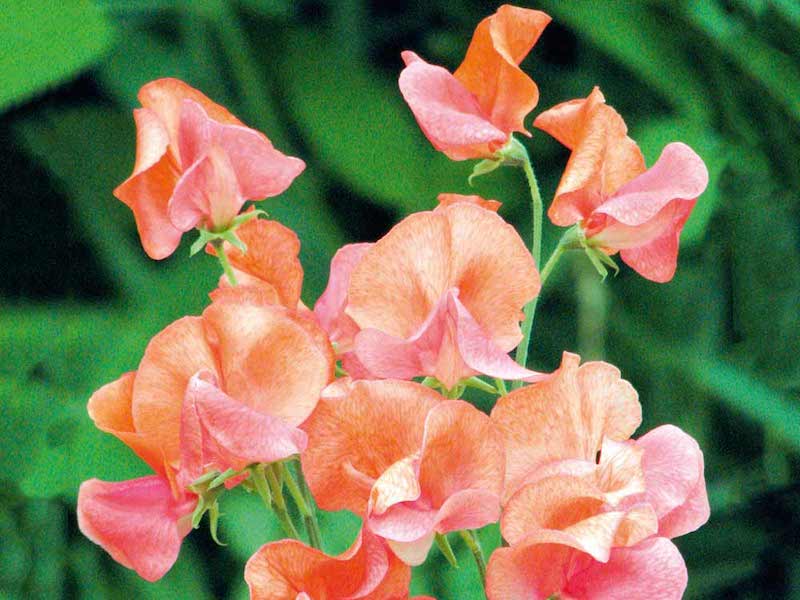To many people, sweet peas are the most beloved old-fashioned garden flower. Their bright, fragrant flowers make me think of cottage gardens and the charm of the country. You may know that sweet peas are usually grown on trellises, but did you know that you can also grow them in hanging baskets? With the right care and variety choice, growing sweet peas in hanging baskets can be a fun and easy way to enjoy these lovely vines.
At our garden center, hanging basket sweet peas have become an increasingly popular item Customers love being able to decorate their patios, porches, and balconies with cascading vines and vibrant blooms. We’ve found that compact, bushy sweet pea varieties thrive best in the confined space of a hanging basket When given proper support, water, and care, they will reward you with months of fabulous flowers and sweet summertime scent.
Benefits of Growing Sweet Peas in Hanging Baskets
There are many advantages to displaying sweet peas in hanging baskets:
-
Ideal for small spaces like balconies, patios, and porches where ground space is limited.
-
Cascading vines and flowers create a beautiful display
-
Position near walkways or doors to enjoy the fragrance.
-
Provides sturdy support for the delicate vines.
-
Avoids issues with sweet peas competing with other plants in garden beds.
-
Prevents invasive varieties from taking over the garden.
-
Lets you customize with your choice of basket, mix of colors and varieties.
Tips for Success with Hanging Basket Sweet Peas
Follow these tips to grow thriving, prolific sweet peas in hanging baskets:
-
Use a high quality potting mix – Sweet peas require loose, fertile soil to grow their deep roots. Choose a commercial quality potting mix blended with compost or manure to provide nutrients. Mix in extra perlite or vermiculite to improve drainage.
-
Select compact, bushy varieties – Look for dwarf, patio type sweet peas under 1 foot tall that won’t outgrow the basket too quickly. Some good options include ‘Bijou’, ‘Cupid’, ‘Knee-Hi’, and ‘Little Sweetheart’.
-
Install support for vines – Insert a small trellis or tepee into the basket center. Or attach vertical strings inside the basket for tendrils to climb.
-
Check the soil every day and water it when the top one to two inches get dry. Avoid overwatering which can lead to root rot.
-
Feed plants often—To get flowers, feed plants a balanced liquid fertilizer every two to four weeks during the growing season.
-
Prune for shape and size – Pinch back leggy shoots and remove spent blooms to promote bushy, compact growth that fits the basket.
-
Grow in cool conditions – Position baskets in partial shade in hot climates to help extend the growing season.
Step-by-Step Guide to Planting Sweet Peas in a Hanging Basket
Follow these simple steps for gorgeous hanging basket sweet peas:
1. Select a Sturdy Hanging Basket
Pick a hanging basket that is at least 10 to 12 inches wide and 8 to 10 inches deep to give the roots plenty of room to grow. Make sure the bottom of the basket has holes for drainage so the soil doesn’t get soggy.
2. Fill Basket with Quality Potting Mix
Fill the basket about 3/4 full with a commercial potting mix blended with compost or manure. Mix in perlite or vermiculite to improve drainage.
3. Sow Seeds Directly in Basket
Plant 2-3 sweet pea seeds 1 inch deep and 2 inches apart in a grid pattern throughout the basket surface. Gently cover seeds with potting mix.
4. Install Support System
Insert a small trellis or tepee into the center of the basket. Or attach vertical strings along the inside for vines to climb up.
5. Water Sparingly Until Germination
Water gently to moisten the potting mix without washing out seeds. Place basket in full sun, watering just enough to keep soil slightly damp as seeds sprout.
6. Thin and Transplant Seedlings
Once seedlings emerge, snip off all but the strongest plant in each spot. Transplant thinned plants to fill any gaps.
7. Grow on in Cool Conditions
Move basket to a shady location protected from hot afternoon sun. Maintain evenly moist soil and feed with diluted fertilizer every 2-4 weeks.
8. Prune to Promote Bushy Growth
Pinch back lanky shoots and remove spent blooms. Train vines along support strings as they lengthen.
9. Harvest Sweet Pea Blooms
Enjoy picking sweet pea flowers for bouquets. Deadhead promptly after cutting blooms to encourage more flowers.
With proper care, your hanging basket sweet peas will reward you with months of fabulous flowers and sweet fragrance. Try mixing colors and varieties for endless decorating possibilities.
Frequently Asked Questions about Growing Sweet Peas in Hanging Baskets
Here are answers to some common questions about cultivating sweet peas in hanging baskets:
What are the best sweet pea varieties for hanging baskets?
Look for compact, bushy varieties under 1 foot tall like ‘Cupid Mix’, ‘Bijou’, or ‘Knee-Hi’. Most tall climbing varieties will quickly outgrow a hanging basket.
How many sweet pea plants should I put in a hanging basket?
Aim for around 8-12 plants in a 10-12 inch wide basket. Space seeds 2 inches apart allowing each plant to fill in its own section.
Is potting soil okay to use for hanging basket sweet peas?
Yes, a quality potting mix with added perlite/vermiculite for drainage works perfectly. Avoid regular garden soil which may be too heavy.
How often should you water hanging basket sweet peas?
Check soil daily, watering when the top 1-2 inches becomes dry to the touch. Avoid overwatering which can encourage diseases.
Should I fertilize sweet peas in a hanging basket?
Yes, feed with a balanced liquid fertilizer diluted to half strength every 2-4 weeks to fuel prolific blooms.
How much sun do hanging basket sweet peas need?
Aim for at least 6 hours of direct sun daily. Provide afternoon shade in hot climates to prolong the growing season.
Growing sweet peas in hanging baskets with the right care will yield stunning results. The gorgeous vines and fragrant blooms will transform any outdoor space into a floral wonderland. We invite you to stop by our garden center to shop our selection of hanging basket sweet peas and supplies. Our experts would be happy to answer any questions and offer tips to help you succeed. Let us help you create a beautiful basket display!

Best advice on how to plant out sweet peas

Tips for preparing the ground and practical advice on how to plant out your sweet peas is simply and brilliantly explained in this short video by Carol of The Sunday Gardener. Weather permitting, Carol gets hers out in April. Because they’re vulnerable to slugs when first planted out, she recommends using organic slug pellets just to help get them off to a strong start.
Unless they’re tied or tumbling, sweet peas naturally look for something to cling to. Debbie from @mrsbeesgarden makes her own genius supports using plastic tubing and bamboo canes. Painted in black to striking effect, her homemade sweet pea frames are structurally interesting in their own right and help to get her plants off to a flying start. Scroll her s to see how they work.
If you have limited space in the garden, flowering sweet peas look fantastic tumbling out of hanging baskets. Claire of Claire’s Allotment shows us how to achieve this in her no-nonsense, easy-to-follow video: Potting Out Sweet Peas. Claire hangs her sweet pea baskets by the back door to provide a waft of glorious scent each time she steps out. What a lovely idea!
Over at @emmasallotmentdiaries, Emma also has a fantastic suggestion for planting out sweet peas. She’s created a fun sweet pea teepee which will eventually grow into a “floral covered hideout”. If you haven’t made one before, scroll through her s to see how it turns out!
Best advice on when to sow sweet peas – autumn or spring?

Late March is optimum sweet pea sowing time for enthusiast Alison of The Blackberry Garden, who grows them every year. She says that although autumn sowings haven’t worked out for her, an experiment sowing sweet peas in late January was very successful. It could be worth a try. And you’ll love her trip down memory lane – all inspired by a vintage sweet pea seed packet!
Instagram gardener Katrina, at Homegrown Garden, discovered the joy of growing sweet peas a couple of years ago and now she’s hooked, as her self-portrait with a freshly picked bunch of white and burgundy blooms illustrates beautifully. She has sown in spring before but, because she likes her displays to start as early in summer as possible, she’s resolved to sow sweet pea seeds in autumn from now on.
There’s no mistaking Alan of Down to Earth’s preference in his post: Sow Sweet Peas in Autumn. You can’t say it clearer than that! A former nursery owner, he says you definitely get the best sweet peas from an autumn sowing, but adds that late winter and early spring are next best – the more the merrier!
“Last year I decided to sow sweet peas in the autumn and they were so much stronger in the spring,” says Hannah from @wildflowersofsussex. This professional florist is now a confirmed October sower, and definitely recommends starting them before winter sets in.
Whenever you decide to sow your seeds, if you want bushy plants that are smothered with flowers, don’t forget to pinch out the growing tips, says Tanya of Lovely Greens. Just one of Six Easy Tips for Growing Sweet Peas, she explains that you should “pinch out the top part of the plant just above the first set of leaves” as soon as your plants reach 4-6” tall. Then they will channel their energy into growing side shoots giving you double the number of blooms.
And if you run out of time or space, or have a problem germinating the seeds, don’t despair. The horticulture team at Suttons says to buy sweet pea plants that are ready to be hardened off and planted outside in the spring. Don’t miss the chance to fill your home and garden with these happy, fragrant flowers because a mouse got into your greenhouse or you missed the sowing window! They even give you ideas for new kinds to try.
